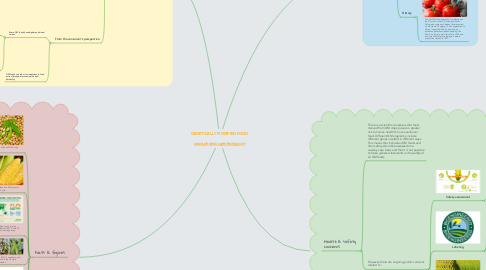
1. Why are GM foods produced?
1.1. From the producer’s perspective
1.1.1. GM crops have been developed to improve yield by:
1.1.1.1. accelerating growth
1.1.1.1.1. In 2016, salmon were genetically modified with growth hormones to reach normal adult size much faster.
1.1.1.2. making the plant more hardy and resistant to diseases or tolerant of herbicides
1.1.1.2.1. Most of the corn and soybean grown in the US has been genetically modified to be resistant to herbicides, so that it’s easier to spray fields with weed killer.
1.1.1.3. introducing novel food products
1.1.1.3.1. Golden rice, named for its yellow color furnished by the beta-carotene in its grains, was hailed as a potential solution to the suffering and illness caused by vitamin A deficiency.
1.2. From the consumer's perspective
1.2.1. Some GM foods have higher nutritional values.
1.2.1.1. The Amflora potato produces a more industrially useful blend of starches.
1.2.1.2. Soybeans and canola have been genetically modified to produce healthier oils.
1.2.2. GM foods can allow for reductions in food prices through improved yields and durability.
2. Facts & figures
2.1. Soybean count for half of all GM crops grown worldwide.
2.2. GM corn has between 6 to 25% greater yields than non-GM corn.
2.3. The US was the leading country in the production of GM foods in 2017, with 25 GM crops having received regulatory approval.
2.4. In 2015, 92% of corn, 94% of soybeans, and 94% of cotton produced in the US were genetically modified strains.
2.5. The first GM animal to be approved for food use was AquAdvantage salmon in 2015. This Atlantic salmon was transformed with a growth hormone-regulating gene from a Pacific Chinook salmon, enabling it to grow year-round instead of only during spring and summer.
2.6. Humans have grown GMOs as early as 12,00 BC through selective breeding of crops and livestock.
3. Background
3.1. What is it?
3.1.1. Genetically modified food (GM food) is food produced from plants or animals whose genetic material (DNA) has been altered in a way that does not occur naturally by mating and/ or natural recombination. These genetically modified organisms are often called GMOs for short.
3.1.2. The technology is often known as ‘modern biotechnology’, ‘gene technology,’ or ‘genetic engineering.’ It allows selected individual genes to be transferred from one organism into another, also between non-related species
3.2. History
3.2.1. The first GM food approved for release was the Flavr Savr tomato. Developed by the Californian company Calgene (later acquired by Monsanto Company), it was engineered to have a longer shelf life by inserting an antisense gene that delayed ripening. The Flavr Savr tomato was first sold in 1994, and was only available for a few years before production ceased in 1997.
4. Health & safety concerns
4.1. There is a scientific consensus that food derived from GM crops poses no greater risk to human health than conventional food. Different GM organisms include different genes inserted in different ways. This means that individual GM foods and their safety should be assessed on a case-by-case basis and that it is not possible to make general statements on the safety of all GM foods.
4.2. However, there are ongoing public concerns related to :
4.2.1. Safety assessment
4.2.1.1. Each GM food needs to be tested and passes safety assessments before being allowed on the market. The safety assessment of GM foods generally focuses on :
4.2.1.1.1. (a) direct health effects (toxicity)
4.2.1.1.2. (b) potential to provoke allergic reaction (allergenicity)
4.2.1.1.3. (c) specific components thought to have nutritional or toxic properties
4.2.1.1.4. (d) the stability of the inserted gene
4.2.1.1.5. (e) nutritional effects associated with genetic modification
4.2.1.1.6. (f) any unintended effects which could result from the gene insertion
4.2.2. Labeling
4.2.2.1. As of 2015, 64 countries require labeling of GMO products in the marketplace.
4.2.2.2. US and Canadian national policy is to require a label only given significant composition differences or documented health impacts, although some individual US states (Vermont, Connecticut and Maine) enacted laws requiring them. In July 2016, Public Law 114-214 was enacted to regulate labeling of GMO food on a national basis.
4.2.2.3. In the European Union, all food (including processed food) or feed that contains greater than 0.9% GMOs must be labeled.
4.2.3. Environmental impact
4.2.3.1. Issues of concern include:
4.2.3.1.1. the capability of the GMO to escape and potentially introduce the engineered genes into wild populations
4.2.3.1.2. the persistence of the gene after the GMO has been harvested
4.2.3.1.3. the susceptibility of non-target organisms (e.g. insects which are not pests) to the gene product
4.2.3.1.4. the stability of the gene
4.2.3.1.5. the reduction in the spectrum of other plants including loss of biodiversity
4.2.3.1.6. increased use of chemicals in agriculture
4.2.4. Regulations
4.2.4.1. The legal and regulatory status of GM foods varies by country, with some nations banning or restricting them, and others permitting them with widely differing degrees of regulation.
4.2.4.2. In the US, GM crops are regulated by three agencies. - FDA (Food and Drug Administration): checks the chemical composition of organisms for potential allergies. - USDA (United States Department of Agriculture): supervises field testing and monitors the distribution of GM seeds. - EPA (United States Environmental Protection Agency): monitors pesticide usage, including plants modified to contain proteins toxic to insects. Like USDA, EPA also oversees field testing and the distribution of crops that have had contact with pesticides to ensure environmental safety .
